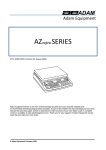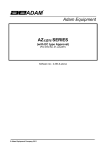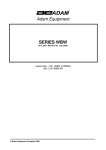Download B&B Electronics Strain Gauge/Load Cell Bridge Amplifier FBDA Service manual
Transcript
. Adam Equipment CBK-M SERIES Service Manual Software rev.: 4.07 & above ADAM EQUIPMENT CO. LTD. P.N. 9017, Rev. A3, October 2007 © Adam Equipment Company 2007 © Adam Equipment Company 2007 CONTENTS 1.0 INTRODUCTION.......................................................................................................2 2.0 SPECIFICATIONS ....................................................................................................3 3.0 TROUBLESHOOTING ..............................................................................................4 4.0 ERROR CODES .......................................................................................................5 5.0 CBK-M DESCRIPTION .............................................................................................6 6.0 LOAD CELL DAMAGE..............................................................................................6 7.0 CALIBRATION ..........................................................................................................9 7.1 7.2 8.0 8.1 8.2 8.3 8.4 8.5 8.6 8.7 8.8 8.9 SECURITY SEALS ..............................................................................................10 CALIBRATION PROCEDURE .............................................................................10 FACTORY PARAMETERS .....................................................................................11 F1 -CALIBRATION................................................................................................12 F2 -RESOLUTION ................................................................................................13 F3 – CAPACITY....................................................................................................13 F4 -INITIAL ZERO RANGE ...................................................................................13 F5 -RE-ZERO RANGE .........................................................................................14 F6 -SUCCESSIVE TARE......................................................................................14 F7 -A/D COUNT ....................................................................................................15 F8 –ZERO ............................................................................................................15 F9 –LOW VOLTAGE DETECTION .......................................................................16 9.0 WIRING DIAGRAM .................................................................................................17 10.0 MECHANICAL ASSEMBLY ....................................................................................18 ***** © Adam Equipment Company 2007 1 1.0 INTRODUCTION • The CBK-M series of scales provide an accurate, fast and versatile general purpose weighing scales with counting, percent weighing and checkweighing functions. • CBK-M scales are kilogram only scales. • There are 4 models with capacities up to 30kg. • The scales have LEDs to indicate when a weight is below the low limit, between the limits or above the high limit next to the display. These can work in conjunction with an audible alarm for check weighing as well as LCD showing LO, OK and HI. • The scales have stainless steel weighing platforms on an ABS base assembly. • All scales are supplied with a RS-232 bi-directional interface and real time clock (RTC). NOTE: For Approved applications, CBK-M Scales do not come with the RS-232 interface. However, the scales can be supplied with RS-232 interface if they are not to be used for approved applications. • The scales have sealed keypads with colour coded membrane switches and a large easy to read liquid crystal type display (LCD) supplied with a backlight. • The scales include automatic zero tracking, semi-automatic tare, accumulation facility that allows the count and weight to be stored and recalled as an accumulated total. © Adam Equipment Company 2007 2 2.0 SPECIFICATIONS CBK 3M CBK 6M CBK 15M CBK 30M Max 3000 g 6000 g 15000 g 30000 g d= 1g 2g 5g 10 g n= 3000 3000 3000 3000 Max 3kg 6kg 15kg 30 kg d= 0.001kg 0.002kg 0.005kg 0.01 kg Grams Kilograms OTHER SPECIFICATIONS Units of measure Interface Stabilisation Time Kg, g RS-232 bi-directional Interface NOTE: For Approved applications, CBK-M Scales do not come with the RS-232 interface. However, the scales can be supplied with RS-232 interface if they are not to be used for approved applications. 2 Seconds typical Operating Temperature -10°C to 40°C / 14°F to 104°F Power supply 115/230 VAC Mains, 50/60 Hz or 9 VDC, 800 mA through an external adapter Battery Internal rechargeable battery (~90 hours operation) Calibration Not available Display 6 digits LCD digital display with capacity tracker and symbol for unit Scale Housing ABS Plastic, Stainless Steel platform Pan Size 225 x 275 mm / 8.9” x 10.8” Overall Dimensions (wxdxh) 315 x 355 x 110 mm 12.4” x 14” x 4.3” Net Weight 4.1 kg / 9 lb Applications Weighing Scales Functions Weighing, Parts counting, % weighing, Check weighing, Check counting, Accumulation of weights Date/Time Real Time Clock (RTC), To print date and time information- battery backed. NOTE: For Approved applications, CBK-M Scales do not come with the RS-232 interface. © Adam Equipment Company 2007 3 3.0 TROUBLESHOOTING PROBLEM POSSIBLE CAUSE Display is blank No turn on test Power Switch faulty or not connected Battery not charged or faulty Power supply faulty or incorrect type “- - - - - -“appears on display Maximum capacity exceeded Load Cell damaged Electronics is faulty Display is unstable Drafts or air currents Obstruction under pan Sample is moving (animal weighing) Vibrations through table Temperature changed dramatically Electronics faulty or Battery low Weight value incorrect Calibration error, Recalibrate Unit calibrated with inaccurate weight Balance not level Obstruction between sample pan Wrong unit of weight displayed Cannot use Full Capacity Over-load Stops hitting pan support or hitting bottom of load cell Electronics faulty Parameters set incorrectly Load Cell Damaged Not Linear Overload stops hitting too soon Faulty factory calibration © Adam Equipment Company 2007 4 Off Centre Loading error Overload Stops not correct Obstruction under pan Battery will not charge Charging circuit failure Battery Failure Incorrect adapter (below 800 mA) Processor failure 4.0 ERROR CODES ERROR CODE DESCRIPTION POSSIBLE CAUSES Err 1* Time input Error Invalid time entry such as “268970” for the time format “H-m-S”. Err 2* Err 4 Date input Error 34th day of a month is an invalid entry. Initial Zero is greater than allowed (4% of maximum capacity) when power is turned on or when the [Zero/Enter] key is pressed. Weight on the pan when turning the scale on. Excessive weight on the pan when zeroing the scale. Platform is not installed. Improper calibration of the scale. Damaged load cell. Damaged Electronics. Err 6 A/D count is not correct when Load cell is damaged. turning the scale on. Electronics is damaged. Err 7 Percent input error Percent function is entered with no reference mass on the pan. Err 8 High limit input error Low limit is set first, then the high limit is set lower than the low limit and high limit not equal to zero. Err 9 Low limit input error High limit is set first, then the low limit is set higher than the high limit and low limit not equal to zero. FAIL H or FAIL L Calibration error Improper factory calibration). The old calibration data will be retained until the calibration process is complete. *Err 1 and Err 2 are not applicable for scales used in approved applications. © Adam Equipment Company 2007 5 5.0 CBK-M DESCRIPTION The CBK-M scales have an enclosure with all components mounted within it. To gain access to the components remove the 5 screws securing the cover to the base. The basic unit consists of: 9 9 9 9 9 9 9 Base Load Cell frame Power switch Main PCB assembly Battery Display PCB assembly Keypad All models of CBK-M are similar except the selection of load cells and the program. Normally if a problem is found with a circuit board the most cost effective method of solving the problem is to replace the circuit board. The main PCB assembly includes: 9 A/D converter (AU1), 9 Microprocessor (DU1) and 9 Power supply/battery charger circuits (DU5, T2). 6.0 LOAD CELL DAMAGE The most common reason why a scale fails is that the load cell has been damaged. The damage can be from 2 primary causes. The first is physical damage due to an overload or an impact from the side and the second is damage due to the environment, such as moisture, extreme heat or a cut cable if the cables are exposed. PRINCIPLE OF OPERATION The stain gauge load cell is a method of measuring the amount of stress put onto a metal structure due to a weight being supported by the structure. The stress is measured using 4 strain gauge sensors mounted in a particular way on the metal structure. These 4 strain gauges are connected in such a way that they form a Wheatstone Bridge. See figure below. In the simplest load cells there are only the 4 resistances of the strain © Adam Equipment Company 2007 6 gauges to consider. Normally without a load on the load cell all the resistances are the same. However when the load cell has a weight on it 2 of the strain gages will be in compression (A and D) and the resistance will decrease and 2 will be in tension (B and C) and their resistance will increase. +E +E A A B +S B oh m -S 1 35 0 35 C D 9 34 m oh m oh 35 0 m oh +S -S C 9 34 10 VOLT POWER SUPPLY m oh m oh m oh 1 35 0 35 0 35 10 VOLT POWER SUPPLY Vout = O VOLTS, m oh D Vout = 0.028 VOLTS (28mv), BETWEEN +S AND -s BETWEEN +S AND -s -E -E UNBALANCED BRIDGE FULL CAPACITY LOAD ON THE LOAD CELL BALANCED BRIDGE This will cause the bridge to become unbalanced. When the bridge has a voltage across it from +E to -E then the signal output at +S and -S will show a voltage of zero volts with no load and a small voltage proportional to the load as the load is increased. Typical load cells show 20-30mv of signal if the excitation voltage is 10volts and the load cell is fully loaded. Most load cells used in scales are not as simple as this example. They have additional resistance elements added to compensate for temperature variations and to set the outputs to correct voltages. The circuit of a typical load cell is shown below- © Adam Equipment Company 2007 7 A method to check the basic function and integrity of a load cell can be done using a ohmmeter and voltmeter with up to a 10volt power supply. Before the load cell is connected to the power supply use the ohmmeter to measure the resistance between the wires. Typical resistance values are: +E to -E 410 ohms ±30 ohms +S to -S 350 ohms ± 2 ohms +E to +S or any other combination similar approximately 270 ohms. If the load cell has Sense connections in addition they are connected to the excitation internal to the load cell. Connect the load cell +E and -E to a power supply, typically 10 volts. Never use more than 12 volts as it may damage the load cell. Measure the voltage between +S and -S. With no load the voltage should be approximate 0mv ±3mv. With a mass on the load cell the output voltage should increase. The amount by which it increases will be dependent upon the sensitivity of the load cell, capacity of the load cell, the excitation voltage and the amount of mass placed on the load cell. Most load cells have a sensitivity of either 2mv/V or 3mv/V. The expected change to the output is: Vout = (2mv/V) * Vext * Mass capacity of load cell For example a 2mv/V load cell of 30Kg capacity with 20Kg placed on it. Vext is 5 volts would give a output of approximately: Vout = (2mv/V) * Vext * Mass capacity of load cell = 2mv/V * 5V * 20Kg = 6.7mv 30kg If the load cell has been damaged the no load voltage will likely be greater than 3mv or the loaded voltage will be grossly different from the expected value. Remember the loaded voltage will be offset by the amount of zero load voltage measured. © Adam Equipment Company 2007 8 The load cell can be tested while it is connected to the A/D converter circuit board, using the scale power supply for excitation voltage. TESTING LOAD CELLS IN THE SCALE The signal from the load cells is amplified by the circuits on the A/D circuit board. The signal needs to be amplified to make it acceptable for the A/D converter used. The CBK-M scales amplify the input by 200 and change the no load voltage to about +2.5V. The amplified and offset voltage is measured at pin 6 of IC7, the INA118P amplifier IC. This voltage is sent to the filter and then to the A/D converter. 7.0 CALIBRATION The CBK-M Scales are sealed to prevent unauthorised calibration. The calibration of the CBK-M scale is accomplished by removing the label at the base of the scale which covers a hole through which the PCB can be accessed. If your scale is not provided with this hole, you need to break the security seals and remove the top cover to gain access to the circuit boards inside. See the figure on the security seal below. WARNING: CALIBRATION OF THE CBK-M SCALE MAY MAKE IT ILLEGAL TO USE THE SCALE FOR SOME APPROVED APPLICATIONS. CONTACT YOUR TRADING STANDARDS OFFICE FOR FURTHER ASSISTANCE. © Adam Equipment Company 2007 9 7.1 SECURITY SEALS To seal the scale a lead-wire seal can be used as shown below. The base has a metal pin that protrudes through the cover. The security seal may be threaded through this metal pin, making it impossible to remove the cover without damaging either the security seal or the enclosure. Metrology labels and additional security measures may be added to the scale as required by the national legislation. An alternative method of sealing the scales is to have a seal covering the joint between the base and cover. If this seal is broken the scale must be sealed by the relevant authorities, using either the lead wire seal or an acceptable seal between the cover and base. 7.2 CALIBRATION PROCEDURE The scales are sealed to prevent unauthorised calibration. See section 8.1 for details. If calibration is not possible, the load cells or PCBs may have been damaged. Contact Adam Equipment or the supplier. CBK-M scales need to be re-calibrated if the variation in gravity takes place due to change in location or if the calibration done earlier was not correct. As per the requirements of the Metrological authorities the scales should be verified for use after calibration. © Adam Equipment Company 2007 10 8.0 FACTORY PARAMETERS The factory parameters are used performing the factory calibration, setting the capacity and other basic settings. To access these parameters place a jumper into the pins on the main PCB (marked as position J4) through a hole provided on the base of the scale. Turn the scale upside down. Remove the seal covering the hole to access the PCB. Place a jumper through the hole into the pins. If a jumper is not available, short the pins. Turn on the scale using the switch on the base. “P _ _ _ _” Enter “2006” and press [Tare] After the jumper has been placed in the position shown, apply power to the scale. The display will show the software revision number and then ask for a code number, “P _ _ _ _ “. Enter the number 2006 and press [Tare]. The display will show the first parameter “F1 CAL”. To scroll through other parameters press the [Func] key. © Adam Equipment Company 2007 11 The display will show the parameter number then the word describing the function. Press the [Tare] key to enter a parameter. Press the [Zero] key to exit the factory parameter section. Display will show “JP on”. Remove the jumper. The scale will return to weighing. When a parameter is entered by pressing the [Tare] key, the display will guide you through the parameter selected and the options available. The parameters available are: F1 F2 F3 F4 F5 F6 F7 F8 F9 8.1 CAL rES CAP int rE Z SCS Cnt ZE M Ld M To enter the Calibration Resolution selection, not valid for approved units Select Capacity Initial Zero Range Re-Zero Range Successive Tare Enable Display the A/D counts Set zero method Set low voltage detect mode F1 -CALIBRATION “F1 CAL” “UnLoAd ” Press [Tare] Empty the pan by removing the load, if there is any and press [Tare] “Ld1 XX kg” “Ld2 XX kg” “ PASS” Or, “FAiL L ” Load the first calibration weight and press [Tare] Load the second calibration weight and press [Tare] Calibration is complete. Remove the calibration weight. This means calibration has failed. Remove the calibration weight and repeat the process. “JP on” Remove the jumper or shorting of the pins whichever is used. The scale will return to normal weighing. © Adam Equipment Company 2007 12 Suggested Calibration Weights: CBK 3M CBK 6M CBK 15M CBK 30M 8.2 Calibration weight 1 1 kg 2 kg 5 kg 10 kg Calibration Weight 2 2 kg 4 kg 10 kg 20 kg F2 -RESOLUTION NOTE: This value can not be changed for the CBK-M scales. 8.3 F3 – CAPACITY To enter this parameter, press the [Tare] key when “F3 CAP” is shown. The display will show the current capacity. Press the [Func] key to scroll through the options. Press [Tare] to accept the displayed value and return to the parameter or press the [Zero] key to return to the parameter without changing the value. Then press [Func] to advance to the next parameter. NOTE: The scale must be originally built for the capacity selected. The 3 kg unit uses the 5 kg load cells, 6 kg unit uses 10 kg load cells, the 15 kg unit uses 20 kg load cells and the 30 kg unit uses 35 kg load cells. 8.4 F4 -INITIAL ZERO RANGE To enter this parameter, press the [Tare] key when “F4 int” is shown. The display will show the current initial zero range. Press the [Func] key to scroll through the options. © Adam Equipment Company 2007 13 Press [Tare] to accept the displayed value and return to the parameter or press the [Zero] key to return to the parameter without changing the value. Then press [Func] to advance to the next parameter. 8.5 F5 -RE-ZERO RANGE To enter this parameter, press the [Tare] key when “F5 reZ” is shown. The display will show the current re-zero range. Press the [Func] key to scroll through the options. Press [Tare] to accept the displayed value and return to the parameter or press the [Zero] key to return to the parameter without changing the value. Then press [Func] to advance to the next parameter. 8.6 F6 -SUCCESSIVE TARE To enter this parameter, press the [Tare] key when “F6 SCS” is shown. The display will show if the successive tare is “tr on” or “tr oFF”. Press the [Func] key to scroll through the options. Press [Tare] to accept the displayed value and return to the parameter or press the [Zero] key to return to the parameter without changing the value. Then press [Func] to advance to the next parameter. © Adam Equipment Company 2007 14 8.7 F7 -A/D COUNT To enter this parameter, press the [Tare] key when “F7 Cnt” is shown. This parameter allows you to view the A/D counts from the internal A/D converter. This can be an aid to service. Press the [Tare] key to return to the PARAMETER menu. Typical value at zero is 30,000-90,000 (approx.) Typical value at full capacity is 500,000 (approx.) 8.8 F8 –ZERO This parameter allows the normal method of setting zero. To enter this parameter, press the [Tare] key when “F8 ZE M” is shown. The display will show the current settings, “modE 1” or “modE 2”. Press the [Func] key to scroll through the options. Press [Tare] to accept the displayed value and return to the parameter or press the [Zero] key to return to the parameter without changing the value. Then press [Func] to advance to the next parameter. © Adam Equipment Company 2007 15 8.9 F9 –LOW VOLTAGE DETECTION This parameter allows detection of low voltage when the battery wears down. To enter this parameter, press the [Tare] key when “F9 Ld M” is shown. The display will show if the LVD Mode is set to on or oFF. Press the [Func] key to scroll through the options. Press [Tare] to accept the displayed value and return to the parameter or press the [Zero] key to return to the parameter without changing the value. Then press [Func] to advance to the first parameter. Pressing [Zero] will display “JP on” indicating the jumper is still in place. Switch off the scale and remove the jumper. NOTE : TO SECURE THE SCALE, IT IS NECESSARY TO REMOVE THE JUMPER AND RE-SEAL THE SCALE. NOTE: The scale has a special feature for displaying x10 the value of the weight which is a useful tool during testing. Press the [1] key for more than 3 seconds. It will show one extra decimal place making it a high resolution display. Pressing the [1] key again for more than 3 seconds will bring the display back to the normal resolution. © Adam Equipment Company 2007 16 9.0 WIRING DIAGRAM © Adam Equipment Company 2007 17 10.0 MECHANICAL ASSEMBLY © Adam Equipment Company 2007 18 Adam Equipment ADAM EQUIPMENT, BOND AVENUE, DENBIGH EAST INDUSTRIAL ESTATE, MILTON KEYNES, MK1 1SW, U.K. Tel: (01908) 274545 Fax: (01908) 641339 Intl Tel: -44 1908 -274545 Intl Fax: -44 1908 641339 E-Mail Address: [email protected] Test Certicifate Prüfzertifikat Certificat de test Test certificaat Certificato di prova Certificado de prueba The non-automatic weighing instrument Die nicht- automatischen Wägeapparate L’instrument de pesage à fonctionnement non automatique Manufacturer : Type: No of the EC type-approval certificate: Adam Equipment Co. Ltd. CBK-M T7249 / TC7248 Het niet –automatische weegwerktuig Strumento per pesatura non automatico Imstrumento para pesaje non automatico Hersteller : Adam Equipment Co. Ltd. Typ: CBK-M Nr. der EGBauartzulassung: T7249 / TC7248 Fabricant : Type: N˚ du certificate d’approbation CE de type: Adam Equipment Co. Ltd. CBK-M T7249 / TC7248 Corresponds to the production model described in the EC type-approval certificate and to the requirements of the Council Directive 90/384/EEC as amended and to the requirements of the following EC Directives: 73/23/EEC Electrical equipment for use within certain voltage limits (Low Voltage Directive) Entspricht dem in der Bescheinigung über die Bauartzulassung beschriebenen Baumuster, sowie den Anforderungen der EG-Richtlinie 90/384/EWG in der jeweils geltenden Fassung und den Anforderungen folgender EG-Richtlinien: Correspond au modèle décrit dans le certificat d’approbation CE de type, aux exigences de la directive 90/384/CEE modifiée et aux exigences des directives CE suivantes: 73/23/EWG 73/23/CEE Matériel électrique pour utilisation dans des limites de tension définies (Directive Basse Tension) 89/336/EEC 89/336/EWG 89/336/CEE Compatibilité électromagnétique Fabricante Adam Equipment Co. Ltd. Fabrikant : Type: Nummer van de Verklarling van EGtypegoedkeuring Electromagnetic compatibility Elektrische Betriebsmittel zur Verwendung innerhalb bestimmter Spannungsgrenzen (Niederspannungsrichtlinie) Elektromagnetische Verträglichkeit Adam Equipment Co. Ltd. Produttore Adam Equipment Co. Ltd. CBK-M Modello: CBK-M T7249 / TC7248 N. di certificato di approvazione di tipo CE T7249 / TC7248 Tipo: Numaro del certificado de aprobacion de tipo CE: CBK-M T7249 / TC7248 Conform met het model beschreven in de verklaring van EG-typegoedkeuring en met de voorschriften van EG richtlijn 90/384/EEC zoals gewijzigd en met de volgende EG richtlijnen: Conforme al modello di produzione descritto nel certificato di approvazione de tipo CE e secondo le richieste CE direttivo 90/384/CEE come modificato e secondo le rechieste della seguente directive CE Conforme al modello di producion descrito nel certificado di aprobacion del tipo CE e segun los requisitos del CE diretiva 90/384/CEE como modificato e segun los requisitos della siguiente diretive CE 73/23/EEC Laagspanning richtlijn 73/23/EWG 73/23/CEE 89/336/EEC EMC richtlijn 89/336/EWG Signature Unterschrift Signature Handtekening Firma Firma J.S. Cumbach Technical Manager © Adam Equipment Company 2007 Strumenti elettrici per uso entro certi limiti di voltaggio ( Directivo di voltaggio basso) Compatibilita electromagnetico Date Datum Date Datum Date Fache 89/336/CEE 1 October 2007 Instrumentos electricos para uso dentro cierti limites del voltaje (Diretivo di voltaje bajo) Compatibilidad electromagnetico ADAM EQUIPMENT is an ISO 9001:2000 certified global company with more than 35 years experience in the production and sale of electronic weighing equipment. Adam products are predominantly designed for the Laboratory, Educational, Medical, retail and Industrial Segments. The product range can be described as follows: -Analytical and Precision Balances -Compact and Portable Balances -High Capacity Balances -Moisture analysers / balances -Mechanical Scales -Counting Scales -Digital Weighing/Check-weighing Scales -High performance Platform Scales -Crane scales -Medical Scales -Retail Scales for Price computing For a complete listing of all Adam products visit our website at www.adamequipment.com © Copyright by Adam Equipment Co. Ltd. All rights reserved. No part of this publication may be reprinted or translated in any form or by any means without the prior permission of Adam Equipment. Adam Equipment reserves the right to make changes to the technology, features, specifications and design of the equipment without notice. All information contained within this publication is to the best of our knowledge timely, complete and accurate when issued. However, we are not responsible for misinterpretations which may result from the reading of this material. The latest version of this publication can be found on our Website. www.adamequipment.com © Adam Equipment Company 2007































